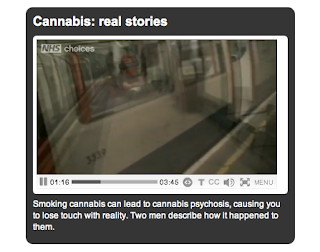I have uploaded the footage of the interview, and now it is on the computer screen, I am aware that the framing needs to be cropped in order to focus the attention on my subject, without distractions. It is clear that there is a lot of blank space, therefore I have experimented to include the best possible technique.
In order to make the interview seem more appealing and aesthetically pleasing to the audience, I am in the process of inserting 'cutaways' to reinforce the argument that the policeman presents. For example, I have included a shot of a cannabis plant when he mentions cannabis. Also, when he mentions harder drugs such as, cocaine and heroine, I have included a snippet from Danny Boyle's, "Trainspotting" which highlights some of the issues like, drug use which I am presenting.
Below is the video which inspired some of the clips I have introduced:
I also feel that by using certain clips from the film "Trainspotting" to reinforce the issues that the policeman raises about how drugs have contributed to the rise in crime levels, the target audience can relate to the film they may have previously watched. This is an example of intertextuality, as the audience can bring their meaning and interpretations to the documentary, providing a deeper insight into the topic.


















